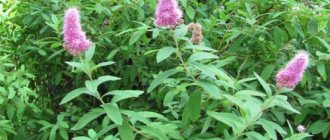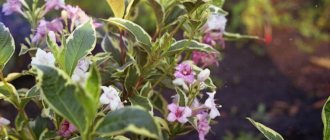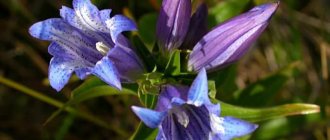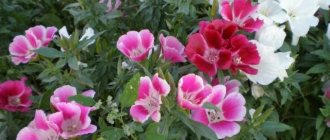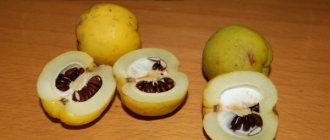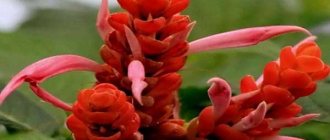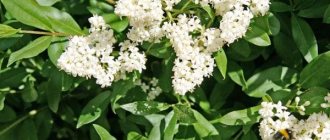Spiraea - planting and care
In home gardens, the spirea flower is one of the most favorite shrubs, because sometimes you only need to plant it correctly to admire the lush blooms year after year, which attract many bees to the area.
Important! The open ground plant thrives wherever the winter temperature does not drop below -35 °C.
What kind of care should be provided for spirea?
To make the shrub look beautiful, it needs to be pruned in early spring or autumn after the leaves have fallen. From 3-4 years of age, it is recommended to fertilize 2-3 times per season with complex mineral fertilizer or mullein solution. Watering will be required if drought lasts longer than 1 month. Bushes are sprayed against diseases for prevention in the spring along with other crops on the site - this is enough to protect against fungal infections.
Where to plant spirea on the site
To propagate an existing bush, you can use cuttings and layering. Only species forms (not hybrids) can be propagated by seeds. Regardless of the chosen variety, a well-lit area located on a small hill should be allocated for planting. Spiraea does not like stagnation of moisture at the roots. Any soil is suitable, but it is worth adding more humus and a small amount of sand before planting for better aeration.
Note! Tall bushes are planted near fences or against the walls of buildings
Application in landscape design
By selecting varieties you can give any garden the necessary mood. For example, plum leaf spirea (S. prunifolia) is widely used to create Japanese-style compositions. An elegant hedge up to 2 m high, beautiful all year round, will be produced by row planting, for example, Spiraea Rowan-leaved. A picturesque contrast with green-leaved crops will be the Viburnum-leaved spirea with its dark burgundy leaves, as well as the Yellow spirea.
Those who need to purchase an ornamental shrub that will look great even without care should pay attention to spirea. Many varieties with flowers of white, pink, yellowish shades of different heights and foliage shapes will help you find your most beautiful solution for the garden
vote
Article Rating
Growing and caring for the plant
Billard's spirea has recently begun to be grown in home gardening. Therefore, many novice gardeners are interested in how to properly care for ornamental shrubs.
Site selection and soil quality
Spiraea is unpretentious to growing conditions. In most cases, a seedling planted in open ground quickly takes root and easily adapts to the new environment. In order for the shrub to delight with beautiful and bright flowering, it is better to look for a place well warmed by the sun.
As for the soil, the Billard variety prefers a loose and nutritious substrate with a neutral acidity level.
We do not recommend planting spirea in lowlands, where melt and rainwater often collects. You should also avoid areas with close groundwater. Author's advice
Landing technique
The best period for planting seedlings is the first ten days of September. Experienced gardeners recommend choosing a cloudy or rainy day for planting shrubs. If the weather is warm and sunny, reschedule the procedure for the evening.
Spiraea root is very delicate and fragile. For this reason, seedlings of ornamental shrubs are sold in containers
Pay attention to the condition of the shoot bark when buying planting material
The best period for planting seedlings is early autumn
Before planting, the seedling is carefully removed from the container and sprayed with a spray bottle. There is no need to remove clods of earth from the root system. Otherwise, there is a high probability of damage to the root processes.
The planting hole should be 40x40 cm in size. The first layer is laid out with drainage material, the second - with fertilizers mixed with soil. When planting, make sure that the root collar remains flush with the ground surface.
If you plan to plant several bushes of Billard's spirea, maintain a distance of 40–50 cm between the holes.
Watering and spraying
Ornamental shrubs are watered as the top layer of soil dries. Try not to overwater the crop. Billarda reacts negatively to excess moisture in the soil. At the end of watering, the tree trunk circle is mulched with hay, straw or peat. A layer of mulch prevents the growth of weeds and maintains moisture levels at the proper level.
Periodically, spirea bushes are sprayed with a spray bottle. Such manipulations should be carried out late in the evening. Otherwise, burn spots may appear on the leaf plates.
Feeding and fertilizer
In the first year after planting in a permanent place of growth, the Billard seedling is fed with nitrogen-rich mullein and bird droppings. Organic matter helps the plant grow green mass.
In subsequent years, flowering shrubs can be fertilized with complex mineral compositions “Kemira Lux”, “AgroMaster”, “Plantafol”, “Sudarushka”, etc.
Pruning rules
Billard's spirea, which is a summer-flowering variety, should be pruned in the fall 1.5–2 weeks before the onset of frost. Old, dried out and damaged shoots are cut off at the root. Healthy branches are shortened by a third. After pruning, the crown of the bush looks like a hemisphere.
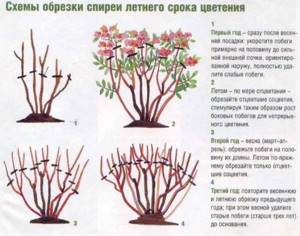
Scheme and algorithm for pruning ornamental crops
Features of preparation for winter
Despite the high threshold of winter hardiness (up to -35 °C), it is better to insulate the ornamental crop for the winter. As a covering material, you can use pine spruce branches, white polypropylene bags or agrofibre.
General information about spirea
Spiraea is an ornamental perennial deciduous shrub from the Rosaceae family. Most species are frost-resistant down to -35°C and undemanding to the quality of the substrate. The bushes are very hardy, successfully survive even in the atmosphere of modern megacities, and easily reproduce both vegetatively and generatively. The only requirement is good lighting.

In nature, most types of spirea can be found in China and Japan.
Flowering, depending on the variety, occurs in April-May or June-September. The flowers are small, collected in dense inflorescences in the form of a shield, panicle or spike. Color varies from snow-white to purple. The bushes bloom in the third year after planting.
By species of spirea we mean those that occur in nature or are bred by crossing them. Based on the species or hybrid, breeders develop varieties. The main goal of such experiments is to create more decorative varieties, distinguished by the unusual color of leaves and flowers, and the shape of the inflorescences.
Types of spirea suitable for creating hedges
In the wild, this unpretentious shrub plant is distributed over a vast territory of the northern hemisphere of the Earth (from the Himalayas to Mexico). There are about 100 of its varieties, which differ in the color of leaves and flowers, the size and shape of the bush, and the flowering period:
- varieties are divided into low- and tall-growing - the first are well suited for decorating and dividing a site into zones, while others, due to their height, allow you to protect the territory of the site from prying eyes;
- the first leaves appear on the bushes already at the beginning of spring, and as the seasons change, they gradually change their color from green, yellow, orange-red to purple;
- The flowering time for early varieties is at the end of spring, for late varieties - in summer;
- the color of the buds is from white to pink, red and crimson, the first flowering occurs in the 3rd year;
- all varieties are honey plants;
- There are different forms of shrubs: erect, creeping, hemispheric, weeping, pyramids, cascades.
With the correct selection of different varieties of spirea for a hedge, you can not only limit the area, but make it bright and colorful throughout the season.
Wangutta
This species is tall (2-2.5 m). Its powerful stems are covered with small bright green foliage with a bluish bloom below and fall in an arched manner to the ground. Their color changes in autumn and becomes orange-red.
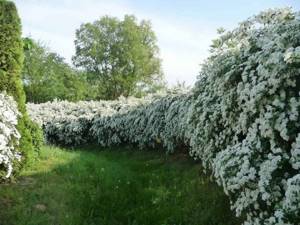
The flowering period begins at the end of May and lasts 20-25 days. The flowers are white, up to 6 mm in size, collected in large hemispheres, flowering is abundant and colorful. The variety is winter-hardy and unpretentious, tolerates shaded areas well, and loves the banks of reservoirs.
Golden Princess
Low-growing shrub (up to 1 m) with a round, spreading crown. The leaves are oval in shape and have a bright yellow hue, for which the variety received the name “Golden Princess”. Flowering time occurs in June-July, the flowers are collected in corymbose-type inflorescences and have a bright pink and red color, size 3-4 cm.
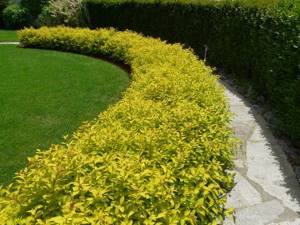
Gray Grefsheim
The variety is tall: its branches fall to the ground from a height of 1.8-2 m. The leaves have a lanceolate shape and are colored first gray-green, then golden-yellow, and in autumn - brown-red.
The flowering period begins already in the 2nd year of life in May and lasts 45 days, the flowers are small (up to 1 cm), snow-white and double. The shrub tolerates pruning well and is winter-hardy. The disadvantage is poor drought resistance; young plants may freeze. Because The variety is a hybrid and cannot be propagated by seeds.

Billard
The bushes grow up to 2 m and have a crown of widely spreading branches. Large leaves up to 10 cm in size have a broadly lanceolate shape. The flowers are large and pink, united in pyramidal inflorescences, the structure is tomentose. The plant is a summer-flowering variety; flowering lasts from mid-July until the first frost.
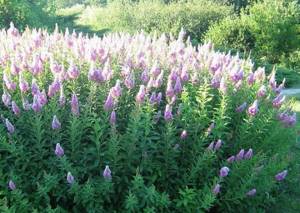
The variety is popular among gardeners in the northern regions, because... tolerates frost well. Reproduction is by cuttings only; fruits are not produced. Experts advise that the first pruning should be carried out only at 4 years of age, because This is how long the plant needs to grow and establish its root system. The optimal time for cutting shoots is early spring. Without pruning, the bush may lose its shape.
Arguta
Spiraea sharp-toothed, or Arguta, is an early flowering species. The shrub has a spreading crown with a height of 1.5-2 m. The leaves are dark green in color, narrow with jagged edges, up to 4 cm long. The plant blooms already from 1 year of life with small fragrant flowers collected in snow-white “umbrellas”.
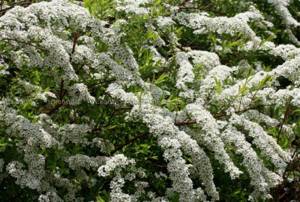
oak leaf
Tall shrub (up to 2 m) with long ribbed shoots that bend down from the weight of large inflorescences. The flowers are white, 1.5 cm in diameter and collected in hemispheres. The leaves are ovoid in shape with sharp tips, about 4.5 cm long, bright emerald on top, and bluish below with a tint.

The flowering period is early May, duration is 25 days. A dense hedge of this type of bush protects the site well from the road and exhaust gases. During the winter months, frost-resistant plants retain snow well. The shrub loves sunny places, but can also grow in partial shade.
Japanese Goldflame
A low-growing variety (up to 60 cm), popular in China and Japan. It is distinguished by a lush spreading crown (up to 1.2 m), which requires annual pruning. Flowering begins in June and lasts 40-45 days. The flowers are small, 4 cm, bright pink. The Japanese variety is frost-resistant and tolerates light shading well.
Spiraea gray description
Spiraea gray is a representative of the large Rosaceae family. It, along with other types of spirea, can easily be classified as so-called low-care plants. This means that for its successful cultivation a minimum of agrotechnical measures is required. Gray spirea is such a wonderful plant - it is at the same time unpretentious, but very impressive and decorative. At the same time, spirea is beautiful even after flowering. Gray spirea is often used in landscape design; it is loved for its wide range of uses: in single plantings, various compositions, and for creating decorative hedges. In combination with other beautifully flowering shrubs, spirea can be used to create the cherished dream of many gardeners - a garden of continuous flowering.
The plant is a highly branched shrub whose height can reach about 2 meters.
The leaves of this spirea are narrow, gray-green on top, and much lighter on the underside. The shoots are drooping, bending down in graceful arcs.
The most valuable qualities of spirea sulfur
This shrub is suitable even for inexperienced gardeners. Spiraea gray is highly valued for the following qualities:
- it grows well in both heat and cold;
- very disease resistant. Spiraea is rarely affected by pests such as aphids, spider mites or leaf rollers, but they are very easy to get rid of;
- the plant requires minimal pruning, which even a beginner can easily handle;
- the bush does not produce root shoots. This means that spirea will not grow throughout the entire area without your participation. Such as, for example, rosehip, fieldfare, blackberry, raspberry, sea buckthorn;
- even when the bush is pulled out, its stem is not exposed. Gray spirea always looks lush, neat, neat, retains its characteristic arched shape and blooms profusely. It is used to fill the lower tier and cover the bare trunks of other plants, for example, lilac, serviceberry;
- It tolerates winter and frost well and does not break under snow cover, therefore it does not require covering for the winter. This also makes caring for it much easier. Due to the high unpretentiousness of spirea, it can be found in any regions and growing conditions: in the northern and southern regions, in steppe and forest belts, in the mountains and on the plains. She feels great everywhere and makes us happy with her appearance. But the best place for flowering and growth of spirea is in places well lit by the sun or with light shade. The soil for spirea is slightly acidic to slightly alkaline, with moderate moisture.
The only thing the plant reacts poorly to is sudden temperature changes. In this case, treatment with drugs with an anti-stress effect (according to the instructions): Epin, Zircon, Domotsvet is very effective. These drugs also have a flowering-stimulating effect.
Billard's Spiraea in landscape design
Billard's spirea goes well with many plants; it is not for nothing that it is so popular among landscape designers. Its neighbors can be other beautiful flowering shrubs and conifers. Compositions with the following plants look good:
- weigela;
- wood;
- viburnum;
- lilac;
- action;
- scumpia;
- willow;
- pine;
- spruce;
- juniper.
Billard's spirea is used in the design of rockeries, mixborders, flower beds, and also as a hedge. The bushes cover well the bare trunks of large trees and tall shrubs.
Billard's spirea can often be found within the city. The plant tolerates the gas pollution of the metropolis well and purifies the air by releasing phytoncides. Bushes are planted along fences, fences, walls - they bring comfort and do not lose their decorative effect even after flowering has ended. Billard's spirea is good both in single plantings and in group plantings, where it often plays the role of the main plant.
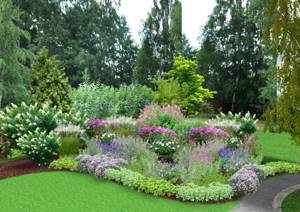
Diseases and pests
Spiraea rarely suffer from disease or insect attacks. Problems arise from improper care.
The greatest danger to the plant is the spider mite. The insect can spread throughout the entire plant and move to neighboring ones. Therefore, it is necessary to combat the pest immediately after its detection. If cobwebs appear under the leaves, they turn yellow and fall prematurely, so the plant must be sprayed with a fungicide. Brown and red spots indicate the development of the disease.
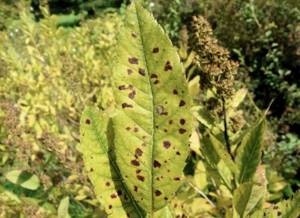
When infected with spotting, the affected areas are removed, and the bush is treated with preparations containing copper
Plant varieties
Numerous spirea got their name from the Greek word for “bend” (Speira), apparently for the beauty and grace of smooth lines characteristic of the branches of all species related to them, of which today there are more than 90.
What all varieties have in common is that they all tolerate urban smog, smoke and gases well. Propagated by dividing the bush, cuttings, seeds and grafting. They grow quickly and already in the third year they delight gardeners with caps of inflorescences. Different flowering times and certain coloring features of the leaf blades allow you to arrange a flowerbed or hedge so that you can admire the play of colors from spring to late autumn.
The species also differ in the natural shape of the bush: erect, cascading, creeping, spherical and pyramidal. The structure of the inflorescence is also different for each variety: spicate, paniculate, corymbose, and there are also single flowers. The leaves differ not only in the silhouette of the plate, but also in color, and on each side.

All numerous spirea are divided into two large groups according to flowering time: summer and spring flowering. The first ones, often pink, red, crimson, appear on the shoots of the current year and remain on the bush for quite a long time. And in the second, flowering occurs on last year's growth, short in time and has a white color. This varietal feature must be taken into account not only when forming a garden, but also when caring for it: early flowering ones are pruned immediately after flowering, while summer ones are allowed to develop their resource until the fall and are pruned only next spring.
Did you know? Due to the content of salicin glycoside in spirea shoots, a well-known medicine was made from it in 1839. It was called "Aspirin".
Combination of spirea with other plants
The neighborhood for spirea is chosen based on the decorative features of this shrub. Medium-sized, up to 1.5 m high, ideal for mixed plantings with coniferous and deciduous trees. Spiraea, located under the spreading crown of the maple, will highlight the beauty of the carved foliage of the tree.
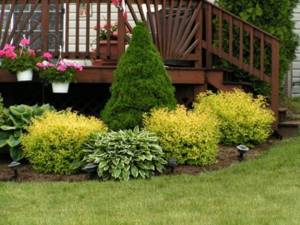
Spiraea can be planted as individual bushes
Looks great next to lilac, viburnum, and willow. Spiraea should not be planted in close proximity to a birch tree, since its flowering shrub will distract attention from the spectacular trunk and crown of the tree.
Care and pruning - bringing beauty
In order for spirea to always delight us with its beauty, it is necessary to properly care for it. All care consists of competent and timely pruning. The main thing is to remember two rules: prune spring spirea before flowering, and cut summer spirea after. It is practically impossible to spoil the plant by excessive pruning. To ensure that the bushes are always lush and green, you need to cut out old shoots every year in the spring. Right at the root. And form the rest the way you like. The main thing is not to do this during flowering.
After the buds have bloomed, they can be removed immediately. This is done so that the plant does not waste its strength and juices to form a seed fund. Subsequently, the spirea bush will bloom again in early autumn. The top of each branch can be cut off. This can control growth and stimulate the development of secondary shoots. Interestingly, every cut bush or twig can be used as planting material.
It is also necessary to remember that, like any plant, spirea needs minerals and fertilizer. But you don't need to do this too often. An adult plant can even survive a slight drought. Feeding can be done two or three times per season, and the first time in early spring. During the dry summer months, it won't hurt to water it, but not too often. A good and developed root system is capable of producing its own food.
After a few years, the spirea may fade a little. To make it come to life again, it is enough to thin it out. Choose an autumn, cloudy day for this so that the roots do not dry out in the sun during transplantation. Water the soil generously and dig up the desired bushes the next day. Free as many roots as possible from the soil; it is better to take this soil to the other end of the garden. Remove all damaged roots and leave strong ones with lateral branches. When planting in a new place, add compost or peat to the hole. Mulch the planting site properly. Do not forget to water every day until the leaves on the bushes rise.
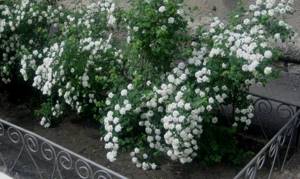
Thinning flower bushes
Do not forget that spirea may be favored by some unwanted insects, such as aphids. And where there are aphids, there are ants. You can get rid of these insects the same way you get rid of aphids from raspberries. For example, a regular solution of soapy water: 2 teaspoons of liquid soap to 2 cups of water. You can also add a little vegetable oil. Spray aphid clusters with this solution and literally the next day you will see the result. The viscous solution envelops the parasites, and the aphids breathe through the skin, and a whole generation of pests will disappear from your garden.
The leaf roller is a moth-like butterfly. Its caterpillar rolls several leaves into a tube and gnaws out the entire contents. In case of danger, the caterpillar crawls out of the leaf and hangs on the cobweb. Usually this insect attacks fruit plants, and if spirea grows nearby, it can become infected with these parasites from them. Avant, Agravertin, Lepidocide will help you cope with it. Summer residents also tear off the affected leaves, collect them and burn them (it is best to crush the caterpillar inside).
One of the dangerous pests of spirea is the spider mite. Its females spin webs on the insides of leaves and lay eggs there. Infected leaves have white spots on the upper side. The leaves soon turn yellow, dry out and fall off. You can cope with the scourge with the help of Agravertin, Actellik, Vertimek, as well as other tick repellents.
If you see blackened ends on the branches, these are signs of fire blight. You need to completely cut out this shoot and burn it.
Spiraea Billard: description and characteristics of the plant
Spiraea is traditionally considered a steppe as well as a mountain inhabitant. This original and colorful plant can be found mainly in America, Northern Europe, and Asia. In Russia, the plant is represented mainly in the Caucasus Mountains.
This plant was known to the ancient Slavs. But if earlier Spirea was used as rods for ramrods, now it can only be found in nature reserves or in garden plots.
Spiraea is considered a real decoration of any garden and this is not surprising, because the flower has an incredible variety of shapes and shades: the plant can have a pyramidal, round or cascading shape. The color of the leaves has a rich palette: it varies from soft green to unusual silver. In autumn - from yellow shades to violet and purple.
16 excellent varieties of plums for the Moscow region
Spirea blooms generously, beautifully and for a long time. Its flowers are represented by small but lush inflorescences of various colors: from white to rich lilac and crimson.
Depending on the flowering time, Spirea is divided into 2 main varieties: summer and spring. The period when the plant blooms largely depends on when it was planted and when the bush was pruned.
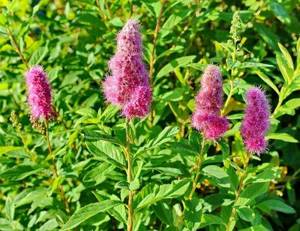
Billard's Spiraea is one of the most popular plant varieties among gardeners and landscape designers due to its unpretentiousness to growing conditions, as well as its unique ability to withstand low temperatures (for this reason, the variety is often grown in harsh northern regions).
The luxurious crimson and pink inflorescences of Spiraea Billarda are held on giant stems reaching 3 m in height, grow quite large (about 20 cm in length) and spread a subtle honey aroma throughout the garden. Despite the densely and lushly blooming inflorescences, the variety does not bear fruit, so the plant can only be used as a decorative element in the garden. The main thing is to carry out spring pruning of bushes on time.
Varieties and varieties for hedges
Currently, about 100 species and varieties of spirea are cultivated. They differ in the shape and size of the bush, the color of flowers, leaves, and the flowering period. The height of a living meadowsweet fence reaches 2.5 m. The flowering period of the plant is short, but it looks attractive until frost. In March, green, variegated leaves sprout on the meadowsweet. Before winter, the foliage has time to change color to yellow, orange or red. There are different forms of deciduous shrubs - erect, creeping, weeping, in the form of a pyramid, a cascade, a hemisphere.
Varieties of meadowsweet bloom at different times of the year. Depending on this criterion, spirea can be spring-flowering or summer-flowering. The first species blooms with white flowers on last year's shoots in early spring. Summer-blooming varieties bloom on newly emerged shoots. The flowers have different shades of red, pink, and crimson. All varieties love light, are frost-resistant, survive well in urban conditions, and germinate on different types of soil. Let's take a closer look at the varieties that are suitable for planting fences.
By selecting different varieties of meadowsweet, you can achieve continuous flowering in the area. Spiraea flowers are small in size, grow singly or are collected in inflorescences of different shapes - panicle, pyramid, spikelet, shield. The bush blooms for the first time in the third year after planting.
Wangutta
The bushes grow up to 2-2.5 m. They were bred by crossing two species - three-lobed and Cantonese spirea. The foliage is green in light tones with a transition to beige spots, and on the inside it is bluish. In autumn it turns red and orange. Vangutta blooms profusely from late May to early June. Flowers spread on last year's shoots. Occasionally re-blooms in late summer. The inflorescences are hemispheres strewn with snow-white flowers measuring 6 mm.

Vangutta tolerates frost well, young shoots freeze a little at the tips. They are pruned in the spring. The bush is growing quickly. The plant does not require any special care. Although soil with good drainage in sunny areas is better for its growth, especially along the banks of streams, ponds, and lakes. Vangutta looks impressive alone, as part of a living fence, as an element of large flower beds. The bush goes well with pine trees and maples.
Golden princesses
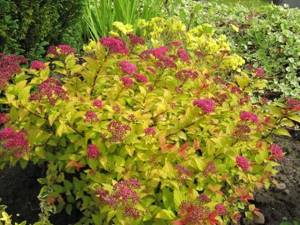
Reaches a height of up to one meter. It has a round crown with a diameter of up to 1.3 m. The oval-shaped leaves delight with a rich yellow color. The “golden princess” blooms for a fairly long period - in June and July. Red, pink flowers measuring three to four cm are collected in corymbose inflorescences.
Gray Grefsheim
The shrub looks like an arch with drooping thick branches. The shoots of this variety are felt-like. The bush usually does not grow higher than 1.8 m. The species received its name due to the peculiar color of the lanceolate leaf blades. They are gray-green, gray on the inside. The Gray Grefstein variety was bred in the middle of the last century by crossing whitish-gray and St. John's-leaved spirea.
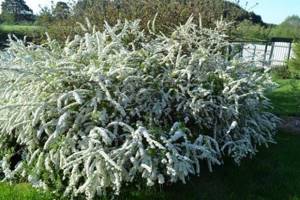
Gray grefstein blooms with snow-white flowers of terry texture. They gather in corymbose dense inflorescences distributed along the entire length of the branches. The shrub blooms in the second year of life. The period of active flowering lasts one and a half months - from May to mid-June. Flowers are small - up to 10 mm. The variety is honey-bearing.
Gray grefstein tolerates the cold season well. The hybrid does not reproduce by seeds. New shoots do not take on the properties of the mother bush. The variety looks good alone or in group plantings. Snow-white shoots are used for decorative bouquets.
Billard
The variety is bred from meadowsweet and Douglas. The bush can grow up to two meters. It has a crown with wide branches on which 10-centimeter wide-lanceolate leaf plates bloom. Pink flowers are united in branched inflorescences-pyramids, reaching 20 cm in length. The inflorescences have a tomentose-pubescent structure. Billarda begins to bloom in mid-July, flowering ends with the first frost.
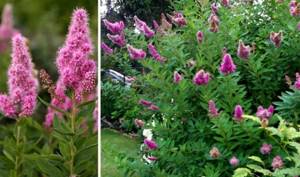
The variety can withstand winter frosts, so it is widespread in northern latitudes. In hybrid species, fruit set and ripening do not occur. Reproduction is carried out by cuttings.
It is not recommended to trim the Billard before 4 years of age. The shrub needs this time to strengthen its roots. By the age of 6, pruning is indispensable, as the bush loses its shape. The shoots are harvested in early spring for the splendor and power of the bush. This stimulates the growth of young branches that bloom the same year. Billard hedges are medium in height and can be planted in groups or as single plants.
Arguta
Arguta is otherwise called Spiraea sharp-toothed. The variety was developed from multi-flowered spirea and thunberg. Spiraea arguta begins to bloom first among other species, in early spring. The bush has a large spreading crown one and a half, maximum two meters high. The narrow, heavily serrated leaves grow up to four centimeters tall and have a dark, rich green color.
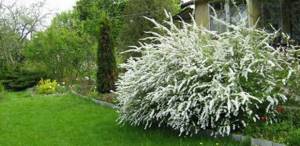
Arguta blooms from the first year of life. Among other species, the shrub is distinguished by its particularly powerful decorative color from the end of spring, lasting about 3 weeks. Snow-white flowers measuring 0.8 cm are collected in umbrella inflorescences and have a unique aroma. The color on last year's shoots covers almost their entire surface. Fallen petals turn the area around the plantings into a fluffy white carpet.
Arguta is not resistant to frost and grows slowly (up to 20 cm in one year). Feels good in urban conditions. Seeds of hybrid varieties do not germinate. The shrub loves light and grows even on dry soil. The shoots should be trimmed after the flowering period has ended. Arguta is popular as a living fencing of plots; it is equally often planted in composition with other bushes, as well as in a single planting.
Japanese
The variety is widespread in China and Japan, hence the name. Shrubs grow up to one and a half meters in height. The oblong leaves are ovoid in shape and cover the felt branches. The foliage is bright green on top, grayish on the underside. In autumn the leaf color changes to yellow or purple. As the foliage ages, it falls off and the branches become bare.
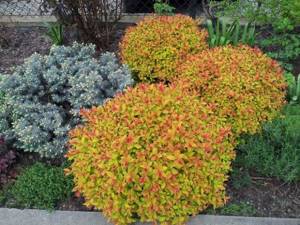
The variety blooms for up to one and a half months during the summer. Small buds with red and pink colors are collected in corymbose inflorescences at the ends of the shoots. Japanese meadowsweet is pruned in the spring to a height of 25-30 cm above the ground. This variety of spirea is often used for planting various forms of living fences and flower beds.
How to properly care?
Caring for spirea of the “Goldflame” species consists, like most plants, in watering, loosening the soil, and fertilizing. Watering is necessary regularly, but moderately. Water should not be allowed to stagnate. You need to especially carefully monitor the bushes in the heat, preventing the top layer of soil from drying out. This slows down the development of the plant and worsens its decorative qualities.
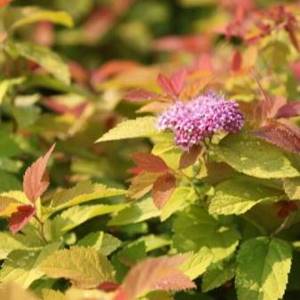
The roots need oxygen supply, so every time you water, you also need to loosen the soil. It is also good to mulch using peat or compost.
The bush will bloom profusely only if the soil is fertile. You can feed spirea with organic and mineral fertilizers. During the growing season, you need to feed the bush no more than 4 times. It is advisable to combine this procedure with watering.
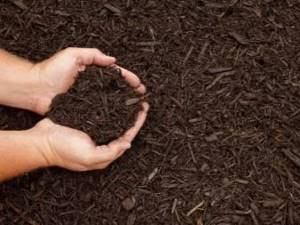
An important point in plant care is pruning, which allows you to beautifully shape the bush. It should be started when the spirea is 4 years old from the moment of planting. There are several pruning options: sanitary, rejuvenating and shaping.
After the winter period, it is important to remove shoots from the bushes that have dried out or been damaged by frost. In autumn it is necessary to cut off the inflorescences
It is advisable to also shape the crown in the autumn months so that it is lush. The plant can be given any shape.
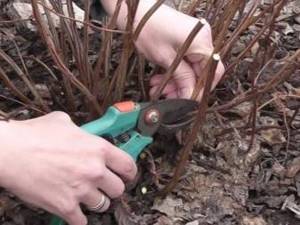
Young bushes need shelter for two years. To do this, you need to loosen the soil and spread mulch in a layer of 15 centimeters. Place burlap on top and sprinkle fallen leaves on it. Then the stems must be bent to the ground, secured with staples and wrapped in non-woven material. When the temperature is fixed at values above zero, you can remove the shelter and remove the staples, freeing the shoots.

How to plant
Planting and caring for Japanese spirea does not require special skills or costs. But to get maximum “output” from the bush, you need to plant it correctly, taking into account the characteristics of the root system, the need for light and moisture.
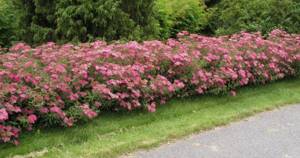
In most regions of Russia, spirea is planted in the spring so that the young plant has time to take root and strengthen before the onset of winter. The main thing is to complete the planting work before the buds begin to swell and the first leaves appear. In the southern regions, autumn planting is allowed, several months before the onset of persistent frosts.
Seedlings can be purchased in specialized stores or nurseries. Pay attention to the buds and bark - they should be “alive”, not overdried. The shoots and roots of high-quality Japanese spirea are flexible, elastic, and do not break or crack when bent. A seedling on which leaves have already blossomed will most likely not take root. Before planting, dry and rotten roots are cut off, healthy ones are shortened to 25-30 cm.
READ MORE: Motoblock Titan 1620 (16 hp, Low gear)
Selecting a location
Japanese spirea prefers well-lit places. Solid varieties with dark leaves tolerate slight shade; variegated leaves lose their contrasting bright color. In the shade, the shrub produces fewer buds, and the inflorescences decrease in size.
Landing technology
Proper planting of Japanese spirea will make further care easier. The area is cleared of weeds in advance, carefully selecting the roots. The soil is dug up with rotted compost. Immediately before planting, dig holes so that the roots of the seedling fit entirely into them. Expanded clay, pebbles or other drainage and a layer of peat mixed with sand are placed on the bottom. The distance between holes should be about 50 cm, and for tall varieties, such as Goldmound, about 1-1.5 m.
The hole is allowed to “settle” for several days. Before planting, pour a bucket of water into it, install the seedling so that the root collar is at ground level, fill it up and lightly compact it. Make a circle around the trunk and water it abundantly again. To prevent the soil from drying out, it is mulched. It is better to plant Japanese spirea in the evening or in cloudy weather.
Reproduction methods
New spiraea japonica goldflame bushes can be obtained using fairly simple methods. The seedlings will turn out to be of high quality and strong if they are rooted correctly and on time.
Layering should be done in early spring, when leaves have not yet appeared on the bushes. To do this, take a young shoot and tilt it as close to the ground as possible.
In this case, it is important to fix it in a lying position using a bracket. Then the shoot must be sprinkled with soil
In the future, it is necessary to carry out timely watering to prevent drying out. With this method, the roots will be formed by autumn. However, the resulting seedling should be separated from the bush only next year. It is important to choose only healthy shoots for seedlings.
Shirobana
Japanese spirea "Genpei" - Shirobana (Spiraea japonika "Genpei" Shirobana), is a low, very original summer-flowering shrub. Its height reaches 80cm. with a crown diameter of 1.2 meters. The length of the felt-pubescent shoots is about two centimeters. They are red-brown and jagged.
The leaves densely strewn with branches are ovoid, somewhat oblong. The "Shirobana" variety has small leaves. Their color is dark green above and dull gray below. In autumn, they decorate the plant, turning yellow and sometimes red.
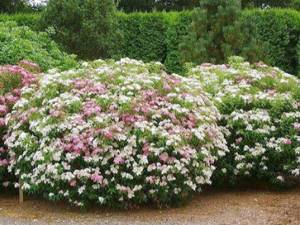
Japanese spirea (spiraea japonica) "Shirobana" resembles a chameleon. It is distinguished by beautiful white, pink and red flowers that cover the bush at the same time, flowering continues throughout the summer until early autumn. When the bushes are covered with double-colored inflorescences, they simply fascinate with their magical appearance. To prolong the existence of such beauty, you need to remove the inflorescences that have already bloomed in time. Flowering ends on the shoots of the current year, the next year flowers begin to appear again on young shoots, and the old branches dry out.
Japanese spirea Genpei (Spiraea japonica Genpei) prefers sunny places and areas with loose, light soil. This shrub has become widespread in Japan and China.
11. Interesting facts
The name “spirea” in Latin means “spiral”, and comes from the thin, elastic branches of the bush. In Greek, the word "speira" means "bend" - and indeed, the branches of various species are often arched.
Spring-flowering plants have another name - “white bride”, as they form long, drooping inflorescences with white buds, and from a distance the bushes resemble a girl in a wedding dress.
When choosing a species, it is worth considering that some plants easily propagate by self-sowing and fill any free space in the garden.
The green parts of plants and shoots contain ascorbic acid, carotene, and spirea is sometimes used in folk medicine as a medicinal plant.

You might also be interested in:
Features of care
Adult spirea shrubs are considered unpretentious in maintenance, but young seedlings that have not yet gained strength should be given more attention and time.
Watering
Planted plants are watered as needed, focusing on the moisture content of the soil underneath them. On average, the bush needs to be watered about twice every 30 days, pouring up to 15 liters of water under the trunk.
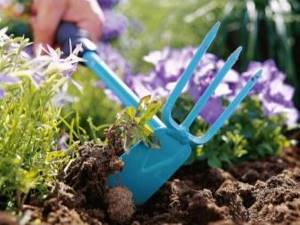
Top dressing
With active crown growth in the first year, it is important to provide the young bush with nitrogen-containing additives, liquid manure and poultry droppings. This can be done once a month
Then every year in spring and autumn it is necessary to feed the bush with phosphorus, potassium and nitrogen fertilizers.

Trimming
If the crop is not pruned for a long time, it will bloom poorly and form few flowers, and then a drastic procedure of pruning “under the stump” cannot be avoided. Therefore, starting from the age of 4 years in the spring, before sap flow, it is recommended to trim all old branches so that their height from the soil is 30 cm. Withered and dried inflorescences after flowering also need to be removed so that the bush does not waste its energy on them.
To prevent insect attacks, in April the soil is treated with the insecticide Pirimor, which helps protect the bushes from aphids; Karbofos and Phosfamide are effective against spider mites.
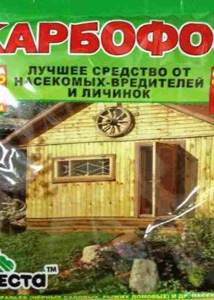
Care for spirea in the garden
Spiraea are quite unpretentious and do not require any special care.
When growing them, attention should only be paid to watering, fertilizing and pruning.
Watering
For normal growth and development of bushes, spirea needs moderate watering. These plants do not like waterlogging and stagnation of water in the soil. But you can’t overdry the soil underneath them, since the plants have a superficial root system. Therefore, it is recommended to water the shrub at least twice a month, watering one plant with ten liters of water at once. Young bushes are watered more often.
After watering around the spirea, loosen the soil and weed out the weeds. These plants do not tolerate soil compaction well and may even die from lack of oxygen if the soil around them is not loosened in time. In autumn, the tree trunk circles are loosened and mulched with peat or compost.
Top dressing
Like all plants, spirea should be fed during care. This should be done at the beginning of the growing season, that is, in the spring. Special complex fertilizers are used, which should be used according to the instructions supplied with them.
Trimming
All spirea shrubs require timely annual pruning. But depending on the variety, it can be preventive or decorative.
Plants that bloom in spring are pruned immediately after flowering. The shoots containing inflorescences are shortened by half, thereby restoring the decorative appearance of the bush. You should also trim off old, weak branches and side branches that thicken the plant.
Spireas that bloom in summer are pruned only in spring. They renew the tops and remove frostbitten branches. The shoots are shortened to the first large buds. Be sure to trim branches that thicken the bush too much. Mature plants undergo more radical pruning. On a bush at the age of four years, shoots only 30 cm long are left.
In one place, spirea bushes can grow for up to twenty years. You should think about replacing a specimen after weak growth begins to appear on it after pruning.
Spiraea gray reproduction
Like any hybrid variety, gray spirea does not reproduce by seeds, but only vegetatively.
Spiraea gray propagation by cuttings
Propagation of gray spirea by cuttings is a fairly simple process. Woody cuttings need to be cut off. The cut is made obliquely. Immediately after cutting, remove some of the leaves from the cuttings, leaving 4-5 leaves, and pinch the crown. Each cutting should be placed 1/3 in a container with water for 2 hours. It is recommended to treat the lower part of the cuttings with a biostimulant to accelerate the growth of the root system. The cuttings should be planted in a mixture of peat and clean river sand, maintaining a 45-degree angle of inclination. During this period, the future spirea requires regular spraying with warm water from a spray bottle, shading from direct sunlight and protection from drafts. Compliance with these rules practically ensures 100% rooting of cuttings. Without preparation, 20-30% of cuttings take root by planting directly into garden soil. Rooted plants can be planted in a prepared permanent place.
Spiraea gray propagation by layering
Since spirea does not produce root shoots, its propagation by layering is not very popular. But it is still practiced using the lower sprouts. To do this, a shallow trench is dug in the ground next to the bush. A shoot from the main bush is placed in it and pinned to the ground. Next, the shoot is covered with a small layer of soil. Layerings require frequent watering, but waterlogging and waterlogging of the soil around the mother bush is dangerous. To speed up and enhance the formation of the root system of the cuttings, you need to pinch the top a little. The optimal time for propagation of gray spirea is July.
Reproduction of gray spirea by dividing the bush
To use the method of propagating spirea by dividing a bush, you need to have certain skills in working with plants. When dividing, you need to correctly determine the place where you can divide the bush. This event is best held in the fall.
The bush needs to be carefully dug up and the soil shaken off from the roots. The plant must be divided so that each division has at least two strong shoots and a sufficiently developed root system.
The delenki are planted in a new place, making sure to water and mulch the plantings.
Other popular varieties of spirea
Spireas are very diverse both in height and in the shape of the bush, leaves and flowers. Let's list the most famous of them.
Has several varieties. Basically, they are all small in stature, with rounded umbrella inflorescences. The height of Japanese spirea does not exceed 1.5 meters. She is very unpretentious and can always decorate your garden.
One of the famous varieties of Japanese spirea is Goldflame. This is a low perennial, about 60 cm high, with a beautiful hemispherical shape. Features golden foliage throughout the season.

A very spectacular spirea that is impossible to pass by. Its branches look like a fountain: bending beautifully, they almost touch the ground. At the ends of the branches there are dense white inflorescences, which look especially elegant against the background of unremarkable gray-green small leaves.
Mature bushes can reach the height of a person, about 180 cm. The flowering of gray spirea is one of the earliest, from mid-May. It is very easy to propagate; sometimes the branches, bending to the ground, take root on their own.

This is a beautiful flowering shrub with a height of one to one and a half meters. The branches are straight, beautiful brown, the leaves are green on one side and silver on the other. During flowering, the entire bush is covered with pink inflorescences in the form of a panicle.
Different types of spirea, planted together, do not give the impression of relatives, they are so different from each other.
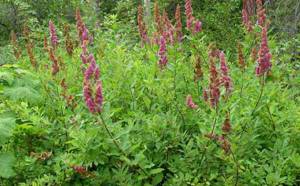
Spiraea hedge: pros and cons of the solution
Spiraea is suitable for forming a hedge for the following reasons:
- Varietal diversity. The height of spirea varies from 20-30 cm to 1.5-2 m - you can create both a border and a real fence. The leaves are not only green, but also lime, yellow, pinkish, the flowers are snow-white, pink, scarlet, purple, the shoots are vertical, weeping and creeping.
- Density and high growth rates of the bush. As a rule, the fence reaches the required dimensions within 3 years after planting. At the same time, spirea blooms for the first time. The “green fence” reliably protects the area from neighbors’ pets, dust and street noise.
- Decorative flowering. Numerous small flowers, collected in inflorescences, from a distance look like lace or openwork foam. It begins in May-June or July and lasts on average 1.5 months.
- Honey production. Any variety of spirea attracts bees and other pollinators to the site, which is very useful for the garden. The aroma of flowers is also pleasant for humans - subtle, unobtrusive.
- General unpretentiousness. Spiraea is not particularly demanding on soil quality and lighting levels. She also needs minimal care - varieties with a flowing crown don’t even need to be pruned.

The varietal diversity of spirea allows you to fit a hedge from it into landscape design with a variety of concepts
The only significant drawback of certain varieties of spirea is low cold and drought resistance. Pay attention to these features when choosing, taking into account the nuances of the local climate.
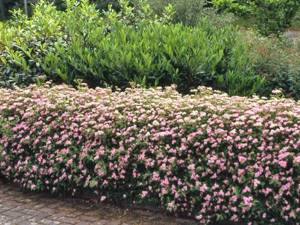
The beauty of a spirea hedge is in its natural form; many varieties require virtually no formative pruning
Video: spirea flowering
Reproduction
After letting your spirea grow and reach 4 years of age, you can begin propagating the variety you like. Remember that Billarda is a hybrid, which means that its seeds will produce heterogeneous seedlings, and seedlings obtained by this method will not inherit the qualities of the parent. Vegetative propagation allows you to preserve all the properties of the mother plant intact and also significantly reduce the time required to prepare a seedling for planting.
In this regard, the fastest way is to root by sprinkling branches that are not separated from the bush. To do this, press those of them that have just begun to bloom leaves to the ground so that the section of the trunk is completely immersed in the soil, in a pre-dug groove. The structure can be secured with a wooden rod, wire, or stone.
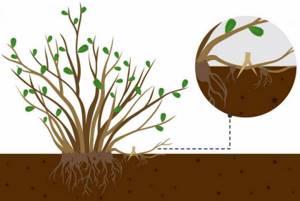
Water thoroughly and wait for rooting to occur. You can cut off the lashes from the mother bush only after stable rooting and the appearance of the first independent shoots. But from one branch you will get 3-4 strong seedlings. The second no less effective method is cuttings. Sections of stems are harvested from the top or middle of semi-woody, not very old branches.
The length of each is 8–12 cm, the bark is clean, smooth, without flaws or mechanical damage. Before plunging the cuttings into the soil, you can treat the lower cut with Kornevin, and after 3–4 months the first roots will appear. This option is slow, but attractive because it makes it possible to prepare a lot of planting material, for example, for a hedge. Whatever method you choose, it is useful for young plants to remove the first inflorescences so that more energy and nutrients can be used to form roots.

